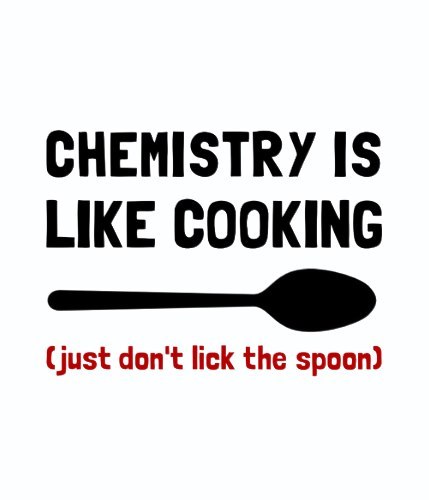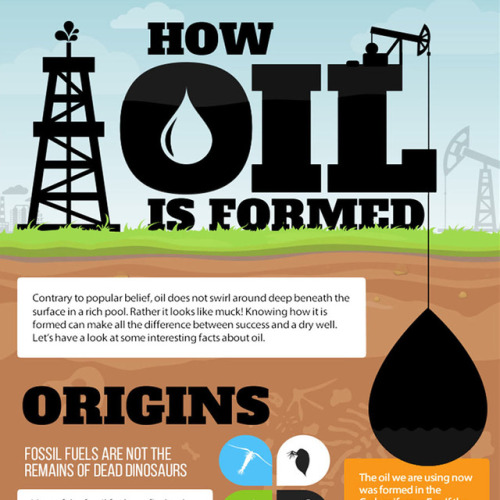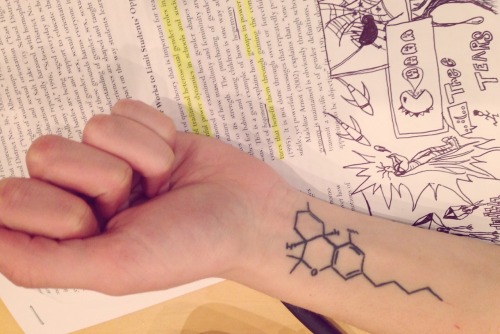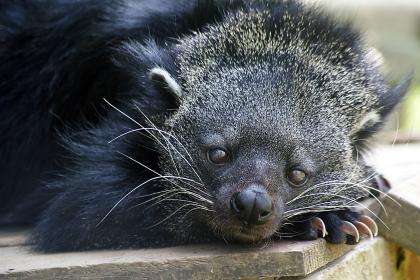#chemical
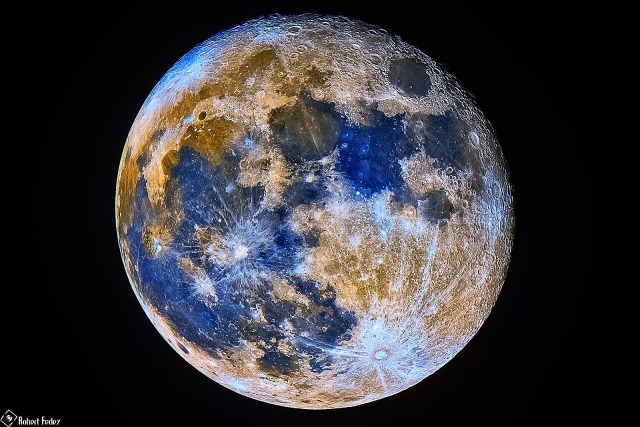
The Moon is normally seen in subtle shades of grey or gold. But small, measurable color differences have been greatly exaggerated to make this telescopic, multicoloured, moonscape captured during a full moon. The different colors are recognized to correspond to differences in the surface’s chemical makeup. Blue hues reveal titanium rich areas while orange and purple colors show regions relatively poor in titanium and iron. The familiar Sea of Tranquility, or Mare Tranquillitatis, is the blue area toward the upper right. White lines radiate across the orange-hued southern lunar highlands from the ray-crater Tycho at bottom right. This image is made up of 272 different images!
Image Credit & Copyright: Robert Fedez
Another month starts in the SCIence Garden with no visitors to appreciate the burgeoning growth of fresh new leaves and spring flowers, but that doesn’t mean we should forget about it!
Hopefully in our absence the Laburnum tree in the garden, Laburnumxwatereri‘Vossii’ will be flowering beautifully, its long racemes of golden yellow flowers looking stunning in the spring sunshine!
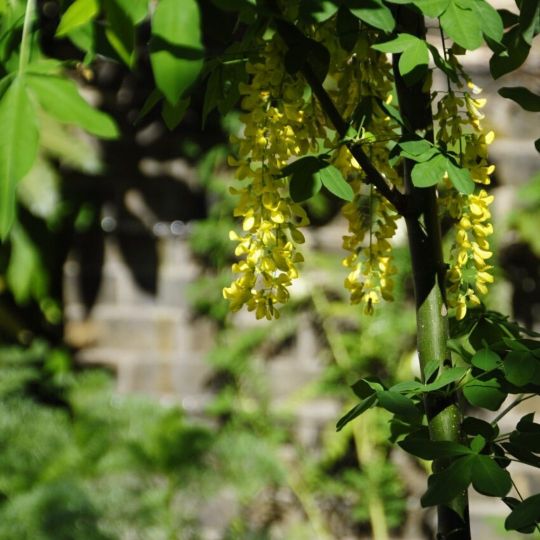
Laburnum x watereri ‘Vossii’ in the SCIence Garden
This particular cultivar originated in the late 19th century in the Netherlands, selected from the hybrid species which itself is a cross between Laburnum alpinum andL. anagyroides. This hybrid species was named for the Waterers nursery in Knaphill, Surrey and was formally named in a German publication of 1893 (Handbuch der Laubholzkunde, Berlin 3:673 (1893)

The laburnum tree is found very commonly in gardens in the UK, and is noticeable at this time of year for its long chains of golden yellow flowers. However, the beautiful flowers hide a dark side to this plant. The seeds (and indeed all parts) of the tree are poisonous to humans and many animals. They are poisonous due to the presence of a very toxic alkaloid called cytisine (not to be confused with cytosine, a component of DNA). Cytisine has a similar structure to nicotine (another plant natural product), and has similar pharmacological effects. It has been used as a smoking cessation therapy, as has varenicline, which has a structure based on that of cytisine. These molecules are partial agonists at the nicotinic receptor (compared to nicotine which is a full agonist) and reduce the cravings and “pleasurable” effects associated with nicotine.

Cytisine is found in several other plants in the legume family, including Thermopsis lanceolata, which also looks stunning in early summer and Baptisiaspecies, also growing in the SCIence Garden and flowering later in the year.

In 2018 there were 9.6 million deaths from cancer and 33% of these were linked to exposure to tobacco smoke.* Since the link between smoking and lung cancer was established in 1950, the market for smoking cessation therapies has increased enormously. In 2018 it was worth over 18 billion dollars annually worldwide and is projected to increase to 64 billion dollars by 2026.** Staggering! Varenicline, sold under the brand names Champix and Chantix, is one of the most significant smoking cessation therapies apart from nicotine replacement products.
If you see a laburnum tree whilst out on your daily allowed exercise this month, have a thought for its use as a smoking cessation therapy!
* Data from the Cancer Research UK website https://www.cancerresearchuk.org/health-professional/cancer-statistics/worldwide-cancer#heading-Zero accessed May 2020.
Written by Alison Foster: Botanical Horticulturist and Science Communicator
As the COVID-19 outbreak increases pressure on the UK’s NHS services and frontline staff, leading scientists and businesses are taking on new initiatives to tackle the outbreak. As there is currently no treatment or vaccine for this virus, researchers are working at unprecedented speed to accelerate the development of a treatment. Businesses are putting in more effort to help those on the frontline of this global crisis.

Below, we have highlighted some of the actions from the chemical industry in the effort to battle COVID-19.
INEOS has managed to built a hand sanitzer plant in the UK and will soon open the facility in Germany, aiming to produce 1m bottles per month each to address a supply shortage across the UK and Europe.
BASF will soon be producing hand sanitizers at its petrochemicals hub in Germany to address the shortage in the region.
Ramping up the supply of PPE, AstraZeneca is donating nine million face masks to support healthcare workers around the world. Alongside this, AstraZeneca is accelerating the development of its diagnostic testing capabilities to scale-up screening and is also partnering with governments on existing screening programmes.
Pharmaceutical company Novartis UK, along with several others, is making available a set of compounds from its library that it considers are suitable for in vitro antiviral testing.
GSK has announced that is donating $10 million to the COVID-19 Solidarity Response Fund. The Fund was created by the World Health Organisation (WHO) to help WHO and its partners to prevent, detect and manage the pandemic

Alongside the efforts and initiatives from industries, to continue to aid those on the frontline of this global crisis, social distancing interventions must remain to flatten the curve.
Research and data modelling has shown that policy strategies, such as social distancing and isolation interventions which aim to suppress the rate of transmission, might reduce death and peak healthcare demand by two-thirds.
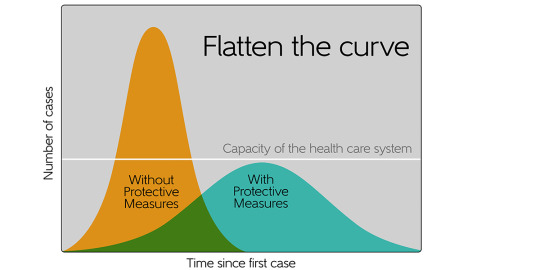
Stopping non-essential contact can flatten the curve. Suppressing the curve means we may still experience the same number of people becoming infected but over a longer period of time and at a slower rate, reducing the stress on our healthcare system.
You slipped some extra fertility drugs in my drinks these past few weeks. My tits are already enlarging, preparing, I’ve commented, saying they’re so sore lately, and you’ve offered to help. I’m way hornier, jumping you whenever possible to get a load in my pussy. I seem to go off into a daze when you’re fucking me, like it’s all I can think about. You love filling up your breeder toy, watching me mindlessly hump your cock like an animal until I feel you cumming.
The test came back, and only a few months later, it’s clear that you’ve certainly bred me so well. I’ve got 5 in me and I’m looking so ripe already, my tits are leaking, huge. I’m already starting to waddle around under the weight of my own womb. You can’t wait to beat that record next time, after all, I’m a proper breeder slut now.
The pregnancy drug worked too well. half way through my workout I began to grow. Waddling past everyone in the gym I think about how to break the news to my roommates and then my parents.
Post link
Sébastien Dubois-Didcock, ‘Refined’
Refined is a photographic body of work embellishing the issues of petrochemistry in our agriculture in hopes to spark awareness.
Each image depicts a subject derived of highly polluting crops, that is unveiled by a stream of “petroleum”; the chemical used to create most of our pesticides and insecticides.
The contrast between the visible petroleum and the invisible food is representative of the dependency these crops have on the petrochemicals used in their production.
While these images are perhaps aesthetically pleasing, their background should remind us that not all progress is progressive.
Courtesy: PX3
Post link
“Toxic design”
In an abstract and personal way, it describes the natural disaster produced by chemical waste generated by the mining of copper and gold in the Apuseni mountains in Transylvania.
This image showing waterways in Geamăna, Transylvania, polluted with waste from copper and gold mining.
Gheorghe Popa /Drone Awards 2021
Post link
You may not know what a binturong looks like… but you probably know what it smells like. The binturong, or bearcat, of Southeast Asia smells distinctly like buttered popcorn! A new study from Duke on the chemical compound in this civit’s urine has determined that the scent’s source is 2-acetyl-1-pyrroline (or 2-AP)– the same compound that makes your mouth water in a movie theater.
Using gas chromatography-mass spectrometry, researchers were able to isolate and identify 29 chemical compounds in binturong urine. Since the animals pee while squatting, their feet and tails are often soaked, which leaves their distinctive aroma on both their bodies and in the branches and leaves of the trees they climb as a kind of scent trail.
What’s more, 2-AP was among the few compounds that lingered and became more dominant over time, a fact the researchers discovered when a rush airmail shipment of frozen binturong urine was delayed on a hot tarmac en route to co-author Thomas Goodwin of Hendrix College in Arkansas for analysis.
The remaining mystery is how they are able to form 2-AP at such low temperatures. In the popcorn popping process, for example, the compound is only released with high heat.
“If you were to make this compound, you would have to use temperatures above what most animals can achieve physiologically,” said Christine Drea, a professor of evolutionary anthropology at Duke who led the study. “How does this animal make a cooking smell, but without cooking?”
Read more on this delicious/disgusting mystery here!
Post link


